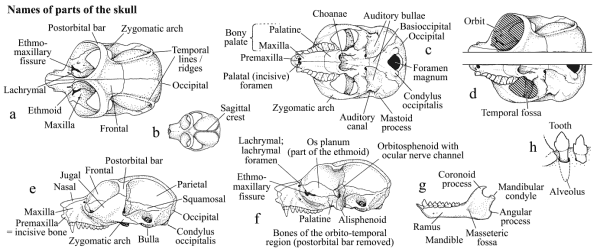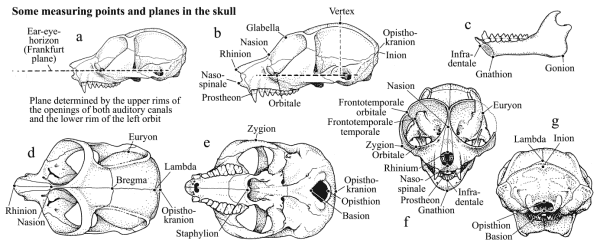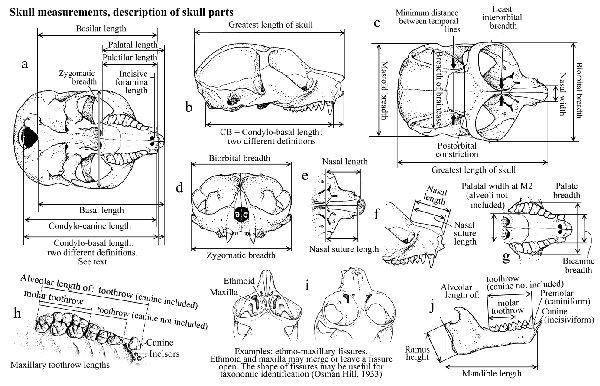
Click to enlarge view
| Home |
|
|
|
|
Errata: definitions after first revision corrected for: alvolar length of molar toothrow, alveolar length of maxillary toothrow, nasal length. Condylo-basal length: apparently two different definitions in use (only one described before update); distinct names for both measurements or clear additional information about measuring method necessary. Corrected in the figures: basilar length, condylo-basal length
Figure 10.1: names of
parts
of the skull
Figure 10.2: some
measuring
points and planes in the skull
Figure 10.3: Skull
measurements
and description of skull parts
Definitions for standardized measuring and description of the skull and measurements found in loris and potto literature
Definitions of some measuring points and planes in alphabetical orderFigure 10.1
Names of some skull parts
Some skull measurements



Definitions for standardized
measuring
and description of the skull and measurements found in
loris and potto
literature, first revision
Errata: definitions
after
first revision corrected for: alvolar length of molar toothrow,
alveolar
length of maxillary toothrow, nasal length. Condylo-basal length:
apparently
two different definitions in use (only one described before
update); distinct
names for both measurements or clear additional information about
measuring
method necessary. Corrected in the figures: basilar
length, condylo-basal
length
Definitions of some measuring points and planes of the head and skull, according to Schultz (1929), Martin (1914) and Mollison (1938), in alphabetical order:
Ear-eye horizon (= Frankfurt horizon, Frankfurt plane): plane determined by the lowest point of the left orbit, which can be determined by palpation in the head with soft tissue, and the two tragion points (= upper edge of the tragus, where it runs into the cheek; if there is no tragus: upper rims of the openings of auditory canals) (Schultz 1929).
Midsagittal plane = median-sagittal plane: plane vertically dividing the head into two more or less symmetrical halves, approximately crossing the three points Nasion, Inion and Basion.
Definitions of further planes for head and skull measurements: see Martin 1914, pp. 478-484.
Definitions of planes of the skull (without soft tissue):
Basion: median point on the anterior edge of the foramen magnum (Martin, 1914)
Glabella: the most prominent point in the midsagittal plane between the superciliary arches (Schultz 1929)
Euryon: most lateral point on the side of the braincase, where it is broadest (not on the zygomatic part) (Martin 1914; one of us: C. Groves)
Gnathion: deepest point in the midsagittal plane on the lower rim of mandible (Martin, 1914)
Gonion: point on the lower and hind edge of mandible most ventrally, caudally and laterally located (based on Martin 1914)
Infradentale: highest point on the alveolar rim of mandible between the median incisors, on the midsagital plane (Martin, 1914)
Inion: The highest point in the midsagittal plane to which the musculature of the neck reaches on the occipital bone (Schultz 1929), on the skull without soft tissue: median point where the lineae nuchae superiores (lines to which the neck muscle is attached) unite, forming a tubercle or rough spot. If the lineae nuchae superiores do not reach the midsagittal plane, the elongation of their visible parts can be used instead (Martin, 1914).
Nasion: point where the nasofrontal and internasal sutures meet (one of us: C. Groves) ( = most proximal point on the median line of Nasalia). Often lying above the deepest depression on the nasal bridge, in heads with soft tissue often difficult to determine so that it is necessary to make an incision at the nasal root (Martin, 1914).
Nasospinale: projection of the lowest point of the lower rim of the nasal opening on the mediansagittal plane (Martin, 1914)
Opisthion: median point on the caudal edge of the foramen magnum (Martin, 1914)
Opisthokranion: the most caudal point of skull on the midsagittal plane (Martin, 1914)
Orbitale: lowest point on the rim of orbit (Martin, 1914)
Prosthion (= Prostheon): point on the midsagittal plane lying on the most posterior edge of bone in the region between the alveoli of incisors (lower rim of upper jaw). In skulls with defect alveolar rims, determination of this point can be impossible (Martin, 1914).
Rhinion: most distal point on the median line of Nasalia (Martin, 1914).
Staphylion: point on the hind part of the hard palate, on the midsagittal plane and on a line connecting the most anterior points of the edge of the palate towards the choanae (Martin, 1914)
Vertex: highest point of the head in the midsagittal plane with the head oriented in the ear?eye horizon (Schultz 1929)
Zygion: most lateral point on the zygomatic arch (Martin,
1914).
Ethmo-maxillary fissure: named and described by Osman Hill 1933 in Loris: a large gap, often, but not always present, consisting of an open anterior part of the suture which connects the Os planum with the maxilla. (Os planum: a roughly quadrilineal large element derived from the ethmoid, posterior half joined with the maxilla, below and behind articulating with palate bone, above with the orbital plate of the frontal and in front with the lachrymal). The ethmo-maxillary fissure differs in size and shape in the different Loris forms (according to Osman Hill it is for instance hammer-shaped in L. t. tardigradus, more or less semilunar in L. t. lydekkerianus and oval in L. t, nycticeboides), and therefore it may be of some taxonomic importance. It may also be present, in a different form, in the other Lorisoids. More detailed description: see Osman Hill 1933, p. 106 f.
Lacrimal = lachrymal bone: small bone at the front part of the medial wall of the orbit
Nasal fossa: deep depression or fossa on the face anterior to the lacrymal canal. A shallow or moderately deep nasal fossa is common among strepsirhines and may be regarded as primitive whereas a distinctly deep fossa might rather be derived (Schwartz, Beutel 1995)
Occiput: hind part of skull / head (occipital region)
Some skull measurements, according to Schultz (1929), De Blase and Martin (1984) and one of us: C. Groves:
Alveolar length of mandibular toothrow: see alveolar length of tooth row.
Alveolar length of maxillary toothrow: see alveolar length of tooth row.
Alveolar length of molar toothrow (definition valid both for maxillary and mandibular toothrows): length of the toothrow from the anterior surface of the first molar near its junction with the edge of alveolus to the posterior surface of the last molar near its junction with the edge of alveolus, premolars not included (one of us: C. Groves), measured with calipers or dividers.
Alveolar length of toothrow (definition valid both for maxillary and mandibular toothrows): definitions of authors vary in the question whether canines are included, so it seems necessary to add information about that: Incisors are not included. In lorises, the canines in the lower jaw are shaped like incisors and part of the toothcomb; the caniniform teeth in the mandible are premolars (see figure); therefore, only the measurement acccording to Groves, see below (without incisor) makes sense.
Alveolar length of toothrow (canine not included): length of the toothrow from the anterior surface of the first premolar near its junction with the edge of alveolus to the posterior surface of the last molar near its junction with the edge of alveolus, measured with calipers or dividers (DeBlase, Martin 1984; one of us: C. Groves).Alveolar length of toothrow (canine included) (Schultz, 1929): length of the upper toothrow from the anterior surface of the canine near its junction with the jawbone to the posterior surface of the last molar near its junction with the jawbone (measured with calipers or dividers). In prosimians with toothcomb only in the upper jaw (see above).
Definition of synonym “maxillary toothrow”: distance from the anterior edge of alveolus of first tooth present in the maxilla to the posterior edge of alveolus of last tooth (De Blase and Martin, 1984). De Blase´s and Martin´s definition is similar to Schultz´s alveolar length of maxillary toothrow because teeth up to the incisor are implanted in the maxilla whereas the incisors are implanted in the premaxilla and therefore not included (one of us: C. Groves).
Basal length: from the anterior edge of premaxilla to
basion
(DeBlase, Martin 1984; one of us: C. Groves).
Basilar length: from the posterior margins of the alveoli of the upper incisors to the anteriormost point on the lower border of the foramen magnum (DeBlase, Martin 1984).
Bicanine breadth (= bicanine width) (Groves, 1998; Schwartz, Beutel 1995): maximum breadth of muzzle across canine alveoli. (See also rostral breadth at point x)
Bicanine width: see bicanine breadth
Bimalar breadth (Osman Hill 1942): see zygomatic breadth: probably a synonym (malar bone = Os zygomaticum)
Biorbital breadth: maximum horizontal distance between outer margins of orbital rims (Schwartz, Beutel 1995). In large-eyed species such as Loris the greatest breadth of postorbital bars is measured over the front edge whereas in other species such as pottos the hind edges of postorbital bars may be broadest. Therefore see also proposition for additional measurement: maximum breadth over postorbital bars.
Biporion breadth = width from porion to porion (Schwartz, Beutel 1995); porion: the most lateral point on the superior margin of the external auditory meatus (one of us: C. Groves).
Bizygomatic breadth (Groves 1998): see zygomatic breadth
Bizygomatic width: see zygomatic breadth
Breadth across bullae (Osman Hill 1933): no definition given; self-explanatory.
Breadth of braincase: greatest width across the braincase posterior to the zygomatic arches (DeBlase, Martin 1984), greatest breadth of the brain-part of the head over the parietal or temporal bones (distance between Euryon points), perpendicular to the midsagittal plane, never taken on or below the ear-eye horizon even though the maximum width should occur there (based on Schultz 1929 and Martin 1914).
Condylo-basal length: two different definitions are in use: from a line connecting the posteriormost projections of the occipital condyles either to prostheon (Motokawa et al. 2001; Groves, 2002 in press) or to the anterior edge of the premaxillae, which may be the nasospinale projecting further forward (DeBlase, Martin 1984; Chihuahuan desert homepage - glossary). To avoid comparison of different measurements, the exact measuring method should be mentioned..
Condylo-canine length: from the anterior edges of the alveoli of the upper canines to the posterior edges of the occipital condyles. Measurement usually taken instead of condylobasal length in forms in which the premaxillae are frequently lost (DeBlase, Martin 1984).
Diastema lengths: see tooth measurement figure. Definitions according to Schultz (1929), De Blase and Martin (1981), Lundrigan (1996), Molez-Verrière and Vincent (1995):
Diastema length, general definition (mandible): from posterior margin of alveolus of last incisor present to anterior margin of alveolus of first cheek tooth present (DeBlase, Martin 1984). In prosimians, the fact that the canine is small and incisiviform and the second premolar is caniniform must be considered.Greatest length of skull (= greatest skul length, total skull length, maximum length of skull): from the most anterior part of the rostrum (excluding teeth) to the most posterior point of the skull (DeBlase, Martin 1984).Diastema length, general definition (maxilla): from posterior margin of alveolus of last incisor present to anterior margin of alveolus of first cheek tooth present (DeBlase, Martin 1984)
Diastema length between specified teeth: (for instance between C and P1): distance from the posterior margin of alveolus of cranial tooth to the anterior margin of caudel tooth specified.
Greatest (skull) length (Groves, 1998): see greatest length of skull
Incisive foramina length: greatest length of the anterior palatal foramina (DeBlase, Martin 1984).
Interorbital width / breadth: see least interorbital breadth
Least interorbital breadth = mimimum interorbital distance (Schwartz, Beutel 1995): least distance dorsally between the orbits (DeBlase, Martin 1984).
Mandible length: greatest length of the mandible, usually excluding teeth (DeBlase, Martin 1984; Groves, 1998).
Mandibular height (Osman Hill 1942): ? no definition given; see also ramus height
Mandibular tooth row (length): see alveolar length of tooth row.
Maximum cranial breadth (Osman Hill 1933): no definition given; should be either biorbital or zygomatic breadth, dependant on skull proportions. (Comparison with measurements of some skulls indicates that this cannt be a synonym for breadth of braincase)
Mastoid breadth: greatest width of skull including the mastoid (DeBlase, Martin 1984).
Maxillary tooth row (length): see alveolar length of tooth row.
Maximum breadth over postorbital bars: proposition in addition to biorbital breadth, if necessary. In large-eyed species such as Loris the greatest breadth of postorbital bars is measured over the front edges of postorbital bars / orbits whereas in other species such as pottos the hind edges or other parts of postorbital bars may be broadest.
Maximum nasal length (Schwartz, Beutel 1995): see nasal length.
Minimum cranial breadth (Osman Hill 1933): no definition given. Comparison with measurements of some skulls indicates that this is probably a synonym for postorbital constriction
Minimum interorbital distance (Schwartz, Beutel 1995): see under "Least interorbital breadth"
Minimum distance between temporal lines: shortest horizontal distance between median surfaces of temporal lines (Schwartz, Beutel 1995; one of us: C. Groves)
Nasal length: distance from the anteriormost point of nasal bones to the posteriormost point, taken along the midline of the skull (De Blase and Martin, 1984). This measurement may be different from nasal suture length if lateral parts of the nasals are longer than the median parts
Nasal suture length: greatest length of the suture along the midline of paired nasal bones, from Rhinion to Nasion (DeBlase, Martin 1984). Compare with nasal length
Nasal width: greatest width across nasals (DeBlase, Martin 1984).
Nasal suture length: greatest length of the suture along the midline of paired nasal bones (DeBlase, Martin 1984).
Nasion-rhinion (Osman Hill 1942): see nasal suture length.
Orbital breadth (Sanderson 1940): no definition given by the author; given values indicate that this measurement is a synonym for biorbital breadth, not the breadth of a single orbit.
Palatal length: from the anterior edge of premaxilla to staphylion (one of us: C. Groves); from the anterior edge of premaxilla to the anteriormost point on the posterior edge of palate (DeBlase, Martin 1984).
Palatal width (alveoli not included) at a specified pair of teeth: usually the width of palate between the medial rims of alveoli of any specified pair of teeth (DeBlase, Martin 1984). Occasionally alveoli are included; if so, this should be mentioned to avoid mistakes: for instance as palatal width (alveoli included) at a specified pair of teeth.
Palate breadth = widest breadth of palate from outside (including the alveoli) (one of us: C. Groves)
Palate length (Groves, 1998): see palatal length
Palatilar length: from the posterior edges of alveolae of first incisors to the anteriormost point on the posterior edge of palate (DeBlase, Martin 1984).
Postcanine toothrow (Groves 1998): = Alveolar length of molar toothrow?
Postorbital constriction: least distance across the top of the skull posterior to the postorbital process / bar (DeBlase, Martin 1984).
Postpalatal length = staphylion to basion length; from the anteriormost point on the posterior edge of palate to the anteriormost point on the lower edge of the foramen magnum (DeBlase, Martin 1984).
Rostral breadth: see bicanine breadth
Rostral breadth at point x: breadth of rostrum taken at any designated point, usually at the suture between premaxillae and maxillae, but also for instance at a certain tooth, e. g. rostral breadth at M1 (DeBlase, Martin 1984). See also bicanine breadth.
Skull height (Osman Hill 1933, 1953): no definition given by Osman Hill. Martin (1914) compares several measurements and recommmends basion-bregma distance as the most useful one.
Tympanic bullae length: greatest length of bullae (DeBlase, Martin 1984).
Tympanic bullae width: greatest width of bullae (DeBlase, Martin 1984).
Zygomatic breadth = bizygomatic breadth, bizygomatic
width, bimalar
breadth: greatest distance between the outer margins of the
zygomatic arches,
distance between zygion points (Groves, 1998; De Blase &
Martin, 1984).
|
Lorises and pottos: species,
subspecies, local
populations. In: http://www.species.net
|
Last amendment: 22 March 2003
|